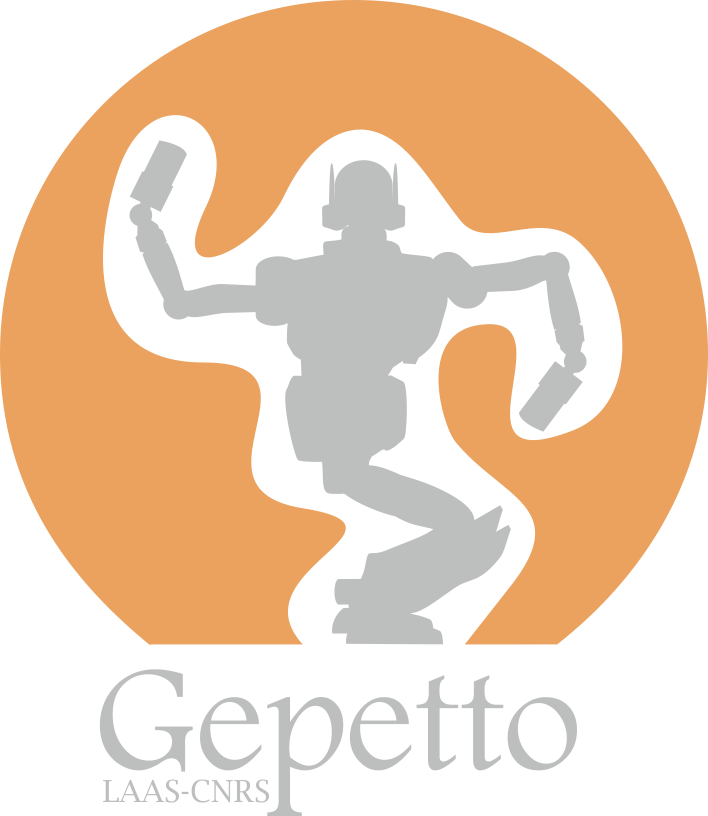Olivier Roussel
|
Email: olivier.roussel ( at ) laas.fr |
 |
Short Bio
I obtained my M.S. degree in Robotics from University of Toulouse III in 2010. Then I worked as a Research Engineer at CEA-List
from April 2010 to June 2012 on humanoid path planning (combinatorial planning using convex cells partitionning) and crowd simulation.
Between September 2012 and October 2015, I was a Ph.D. Student at LAAS-CNRS and University of Toulouse III under the supervision of Dr. Michel Taïx as part of the ANR Flecto project in collaboration with CEA-List and KineoCAM. From August to November 2014, I was a visiting scholar at the Bretl Research Group at the University of Illinois at Urbana-Champaign.
I defended my Ph.D. October 5th, 2015. You can watch the video of the defense (in French), read the manuscript (in French) or obtain more details at this page.
Research Areas and Interests
My researches focus on various aspects of robotics, such as motion planning, optimization, multi-body dynamics, elasticity, optimal control, differential geometry and mathematical modelling. I am also still very interested in my previous research work, i.e. computer graphics, collision detection and crowd simulation.
Inverse geometry of quasi-static elastic rods
Considering an elastic rod handled by grippers at its both extremities, it is well known that for a given grippers placement, there exists a finite number of static equilibrium configurations satisfying these boundary conditions. Using a new closed-form expression of elastic rods internal wrenches, we propose an approach to solve the inverse geometry problem, i.e. finding one configuration of the rod that satisfies a given grippers placement. More precisely, in the planar case, analytic forms of rod shape and sensitivity can be obtained from elliptic functions and integrals. These can be coupled with some numerical optimization methods to solve efficiently the inverse geometry problem in the planar case.

Resolution of the inverse geometry problem for planar elastic rods at equilibrium configurations |
- Closed-forms of planar Kirchhoff elastic rods: application to inverse geometry. Olivier Roussel, Marc Renaud and Michel Taïx. In IMA Conference on Mathematics of Robotics, page 9p., Oxford, September 2015.


- Closed-forms of Kirchhoff elastic rods shape and sensitivity in the planar case. Olivier Roussel, Marc Renaud and Michel Taïx. Research Report, LAAS-CNRS, March 2015. (Rapport LAAS 15083).


Motion planning for elastic rods
The goal of this research topic is to extend the well-known motion planning formulation to elastic rods. One of the main challenge is to deal with a physically realistic deformable model and to overcome the curse of dimensionality in the resulting configuration space.
- Manipulation planning with contacts for an extensible elastic rod by sampling on the submanifold of static equilibrium configurations. Olivier Roussel, Andy Borum, Michel Taïx and Timothy Bretl. In IEEE International Conference on Robotics and Automation (ICRA 2015), Seattle, United States, May 2015.


- Rod Motion Planning in Admissible Space. Olivier Roussel, Pierre Fernbach and Michel Taïx. In IEEE Transactions on Robotics (submitted to), 2016.


Convergence of dynamic simulation and the static equilibrium model with two different control schemes | 
Experiments in simulation |
- Deformable Linear Object manipulation planning with contacts. Olivier Roussel and Michel Taïx. In Robot Manipulation: What has been achieved and what remains to be done? Full day workshop at IEEE/RSJ International Conference on Intelligent Robots and Systems (IROS), Chicago, United States, September 2014.


- Efficient Motion Planning for Quasi-Static Elastic Rods Using Geometry Neighborhood Approximation. Olivier Roussel, Michel Taïx and Timothy Bretl. In IEEE/ASME International Conference on Advanced Intelligent Mechatronics (AIM), pages 1024-1029. IEEE, July 2014.



Toy scenario | 
Disassembly study |
Click on the picture to get the corresponding video. You will need the Xvid codec.
Motion planning and dimensionality reduction
- Irreducible Motion Planning by Exploiting Linear Linkage Structures. Andreas Orthey, Olivier Roussel, Olivier Stasse and Michel Taïx, 2016. (working paper).


Software
quasi-static elastic rod library
https://github.com/olivier-roussel/qserl
C++ implementation of the parameterization of static equilibrium configurations of elastic rods., including planar and 3-dimensional rods.
Previous Research Work
- Robust and Scalable Navmesh Generation with multiple levels and stairs support. Guillaume Saupin, Olivier Roussel and Jeremie Le Garrec. In International Conference in Central Europe on Computer Graphics and Visualization (WSCG), 2013.






